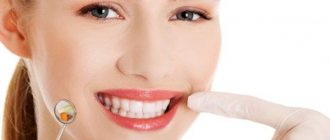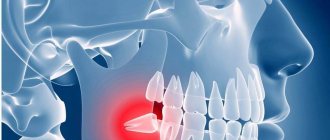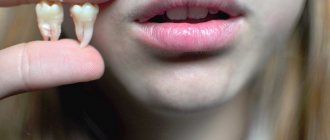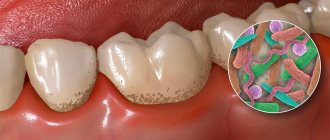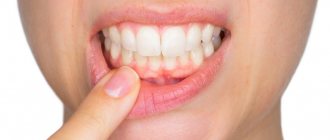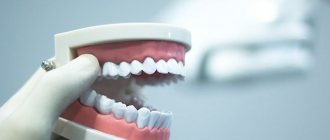Recession represents pathological changes, loss of tissue. As a result of gum recession, the neck and parts of the tooth root are exposed, and the problem causes not only aesthetic discomfort.
In addition to the fact that receding gums spoil the beauty of a smile, many patients note serious discomfort when chewing, increased sensitivity and some pain in the area of the affected teeth. As a result, the disease affects the quality of life. In addition, prolapse can be a symptom of other periodontal diseases and related ailments, inattention to which can be fraught with even more serious consequences.
This disease can occur in people of all ages, but mature and elderly patients are more susceptible to it. It is important to recognize recession in a timely manner and consult a doctor for effective treatment; fortunately, modern methods in many cases allow you to forget about the pathology for a long time.
Recession classification
Receding gums are classified according to their causes into the following types:
- Traumatic - appears as a result of mechanical damage to the mucous membranes. As a rule, the injury is associated with a hard toothbrush and improper brushing technique, which leads to systematic damage. Other common causes of injury include incorrectly installed orthopedic structures - veneers, crowns, etc. Sometimes injury is associated with protruding edges of fillings and elements of braces. It is important to understand that bite defects are also a common cause of recessions: improper distribution of chewing load leads to changes in tissues. Injuries can also be associated with direct pressure on the gums of the teeth. And finally, another group of injuries includes burns, for example, those associated with unsuccessful home bleaching.
- Symptomatic - in this case, the prolapse is associated with some pathological process and serves as its symptom. Usually we are talking about diseases of the gums and periodontal tissues: gingivitis, periodontitis or periodontal disease. They affect mucous membranes and soft tissues, disrupting their trophism. The situation is aggravated by dental deposits in the places where the gums adhere to the tooth; as a result, the tissue simply peels off from the surface of the tooth and the tissue level drops. More rare pathologies manifested by gum recession include other diseases, for example, diabetes mellitus, leukemia.
- Physiological - it develops as a result of a general metabolic disorder, including metabolic disorders in periodontal tissues. In this case, we are talking about the natural processes of aging. However, sometimes receding gums develop at a young age due to the individual structural characteristics of the dental system. The most striking example is a shortened labial frenulum, which leads to tissue tension.
Based on the severity of a recession, it is also classified into three categories:
- light: tissue loss up to 3 mm;
- average: 3−5 mm;
- heavy: more than 6 mm.
Based on the localization of the pathological process, recessions are divided into localized and generalized. In the first case, receding gums are associated with trauma and spread to one or more closely spaced teeth. As a rule, the outer side of the teeth is affected, and the defect is noticeable when smiling.
In the generalized form, the pathology covers the entire dentition on one or both sides. It is more often observed in elderly patients, as well as in people with periodontitis and periodontal disease.
Ask a Question
Why does a recession occur?
The development of a recession can be due to a variety of reasons:
- Plaque and hard deposits. As a result of the formation of deposits, the gum epithelium is displaced.
- Specific structure of the alveolar process of teeth. Sometimes, in the presence of a massive root system, thinning of the layer of cortical bone tissue occurs. This leads to insufficient blood supply to the tissues, the formation of a gap-like defect between the tooth and the gum, and receding gums.
- Improper oral care. Brushing your teeth can damage your gums. This occurs when choosing too hard bristles or improper brushing techniques. With regular damage, the condition worsens, leading to gum recession.
- Injuries. For example, a dislocated tooth.
- Orthodontic treatment. It involves putting pressure on the dentition, displacing the teeth, which in some cases can lead to thinning of the gum tissue. In addition, non-removable structures make hygiene difficult and can directly put pressure on soft tissues.
- Exposure to arsenic. The use of arsenic pastes during endodontic treatment can cause gum loss if the drug gets on the gums.
- Gingivitis or periodontitis. Inflammatory diseases of the gums and periodontal tissues, especially those that last for a long time.
- Short frenulum of the lips.
It should be noted that there are predisposing factors that, in combination with other causes, are most likely to lead to periodontal prolapse. These include a thin gum biotype, as well as the vestibular location of the teeth or anomalies in their position, close attachment of the frenulum of the lips and tongue.
By themselves, these features do not always lead to pathology, but they increase the likelihood of recession, for example, when exposed to bacteria and viruses, injuries, etc.
Symptoms of receding gums
The condition in which the gums recede may be accompanied by other symptoms. Depending on the extent of the pathological process, recession is observed in a limited area, one side or the entire jaw. As a result, the neck of the tooth may be exposed, and with severe loss, part of the root.
This cannot but be accompanied by increased sensitivity of the teeth - increased susceptibility to hot and cold, sour, sweet foods and even mechanical stress. This symptom leads to difficulties while eating.
It is important to understand that some symptoms may indicate concomitant pathologies. So, if recession is observed against the background of whitish, pale gums, we can talk about periodontal disease. Bleeding and red gums often develop with periodontitis and gingivitis.
What will happen if left untreated?
Lack of timely treatment for gum recession can be fraught with more than just aesthetic problems. If there is a gap between the gum and the tooth, food debris and plaque get into it, and this can cause an inflammatory process. As the tissues become thinner and sagging, the following consequences of recession may appear:
- Hyperesthesia, or increased tooth sensitivity, difficulty chewing.
- High risks of caries development, and in the least protected and more vulnerable areas - in the area of the exposed necks of the teeth. At the same time, carious lesions in this area proceed faster and are more quickly complicated by pulpitis and periodontitis due to a thinner layer of enamel.
- Increased risk of developing a non-carious lesion - a wedge-shaped defect.
- High risks of inflammation, swelling of the gums, and the formation of periodontal pockets.
- An increase in the amount of plaque at the roots, which further aggravates the condition.
Complications can result in serious consequences such as loosening and loss of teeth.
Diagnostic methods
If the gum is moving away from the tooth, it is important to see a doctor as soon as possible: in the early stages, recession is faster and easier to treat. Diagnosis involves collecting anamnesis, analysis of symptoms and complaints, examination and instrumental examination if necessary. During the examination, the doctor will assess the width and nature of the gum damage. A periodontal probe can be used for diagnosis - it is inserted into the periodontal pocket to assess the depth of the lesion.
An assessment of the degree of gum damage is calculated by calculating the recession index using the following formula: the number of affected teeth is divided by the total number of teeth and multiplied by 100%. This is how the severity of the disease is determined: less than 25% is a mild recession, 26-50% is moderate, and from 50% is severe.
For diagnostics, a microscope is used, and binocular magnifying glasses are used. The thoroughness of diagnostic measures allows you to accurately select an effective treatment method. In addition, before starting treatment, it is very important to find out the causes of the disease: to determine whether recession is an independent disease or a symptom of another pathology.
Therefore, differential diagnosis with other periodontal diseases in which the gums rise is necessary. To do this, the doctor may prescribe a targeted or panoramic X-ray to assess the condition of bone tissue and detect hidden concomitant diseases.
What to do if your tooth chipped?
See a dentist.
The doctor will remove the broken wall, take x-rays of the tooth, and evaluate its safety. If the tooth is not broken much, the root is not damaged or almost not damaged, then it can be restored. Then the tooth is prepared (if necessary, dental canals are treated, caries and old filling materials are cleaned), how badly it is damaged is assessed and the best way to restore it is selected (filling, inlay or crown). If the tooth cannot be saved, it is removed and replaced with an implant or other available method.
Features of treatment of gum recession
There are conservative and surgical methods, with the help of which it is possible to cope with the problem relatively quickly. The development of a treatment program is always individual and takes into account the severity, causes of prolapse, prevalence of pathology and other conditions.
The first step is always professional teeth cleaning. It is necessary to remove soft and hard dental plaque. Sometimes subgingival tartar is removed, which already makes it possible to reduce the depth of periodontal pockets, and in combination with other methods, cope with the problem completely or achieve a significant improvement.
Drug treatment can solve several problems at once:
- eliminate or prevent gum inflammation;
- strengthen gums;
- improve blood circulation;
- speed up recovery processes;
- activate the growth of mucosal cells and gum tissue.
For this, vitamin therapy, anti-inflammatory drugs and local antibiotics, self-absorbing membranes, etc. can be used. The doctor may prescribe medicinal baths, rinsing with certain solutions or application of drugs to the gums, including at home.
Preparations that activate recovery processes are also widely used: products based on hyaluronic acid, regenerating gels with growth factors. The launch of natural regeneration processes allows you to literally “grow” the gum in the place where it subsides.
Another conservative method is the use of the patient's own blood plasma enriched with platelets. This method is called plasma lifting, or APRF technology. Injections into the gums can be used, as well as special membranes that are placed under the gums, but as part of a surgical intervention. This allows you to quickly restore tissue and improve cell nutrition.
As for other surgical treatments for receding gums, the most common are:
- Flap surgery - gum recession is closed with a gum flap, which the doctor takes from the patient's own tissue located nearby. Intervention is performed when the gum defect is minor and there is a sufficient amount of surrounding tissue that can be used.
- Transplantation of a graft from the hard palate/tuberculum of the upper jaw. In this case, part of the gum or a flap of connective tissue is taken from the donor sites and planted in the defect area. Can be used for all types of recession.
- Combined method: the movement of gum tissue is combined with the collection of tissue from the hard palate. The combination of approaches makes it possible to obtain high aesthetic results and close deep recessions. However, if gum loss is more than 5 mm, multiple interventions may be required.
Closure of gum recession is performed on an outpatient basis under local anesthesia. The choice of type of operation is determined by the condition of periodontal tissues and diagnostic results. All surgical methods are often combined with curettage - cleaning the space under the gum and removing subgingival deposits, and are also supplemented with growth activators.
Home care and postoperative period
After treating gum recession, your doctor may prescribe antibiotics, rinses, topical gels, and other topical treatments to prevent complications and speed up the healing process. It is also important to prefer gentle, soft food at a comfortable temperature, and perform regular hygiene according to the recommendations of a specialist.
The dentist will recommend replacing your hard toothbrush with a soft one, and as healing progresses, you will likely need a toothbrush with medium-hard bristles. In addition, the doctor will definitely show the correct cleaning movements and tell you what pressure will be optimal. In many cases, such measures are sufficient to eliminate the causes of exposed tooth necks, as well as maintain treatment results.
Discomfort in the area of the extracted tooth
Unpleasant sensations, including throbbing pain, after tooth extraction are a natural and inevitable phenomenon, since it takes time to restore damaged tissue.
But after such an operation (especially after the removal of a wisdom tooth), patients should listen very carefully to their feelings so as not to miss the moment of possible complications, such as alveolitis (suppuration of the tooth socket as a result of the loss of a blood clot protecting the wound from infection).
Prevention of receding gums
To prevent gum recession, your doctor may recommend the following measures:
- Timely, regular visits to the dentist: it is important not only to undergo an examination, but also to carry out professional hygiene twice a year. This will prevent the accumulation of plaque and the formation of hard deposits.
- Timely correction of bite, treatment of inflammatory gum diseases, replacement of fillings, careful selection of orthopedic structures.
- Individual selection of oral hygiene products, especially in the presence of periodontal tissue diseases.
- Using dental floss and irrigator. It will not only improve the quality of hygiene and help remove food particles from the interdental spaces, but will also serve as a kind of gum massager, stimulate blood circulation and maintain the health of the mucous membranes. It is important to consult a doctor about the advisability of use, however, modern irrigators provide mild modes of exposure.
- Avoiding mucosal injuries: avoiding uncomfortable orthopedic structures, using special wax when wearing braces.
- Quitting smoking: this bad habit impairs the blood supply to the tissues of the oral cavity and contributes to the formation of a large amount of plaque on the teeth.
You can learn more about treatment and prevention, as well as get quality help if you have gum recession, from the doctors at the STOMA clinics. Experienced periodontists are highly qualified and have a whole arsenal of modern treatment methods: we are ready to offer comprehensive assistance in diagnosis and treatment. You can make an appointment by phone or through a special form on the website.
Discomfort under the filling
Unlike the previous case, pulsation in the gum under a recently filled tooth does not always indicate a mistake by the dentist. It is important to distinguish the stage of treatment here:
- When installing a temporary filling, pain and pulsating sensations are acceptable during the first few days, since temporary filling is most often carried out with the addition of a devitalizing agent to destroy the neurovascular bundle. The killing of the pulp occurs gradually, but a visit to the doctor is justified if the discomfort persists for more than 2-3 days.
- If discomfort is felt under a permanent filling, it is advisable to get dental care as quickly as possible. The causes of pain can be different; a competent diagnosis based on an X-ray examination of the problem tooth is necessary.

